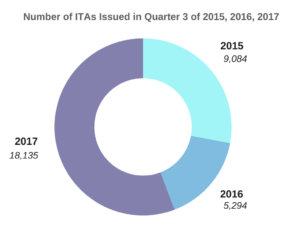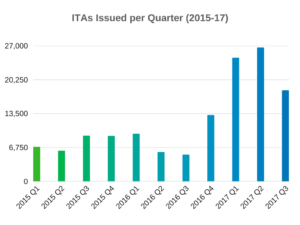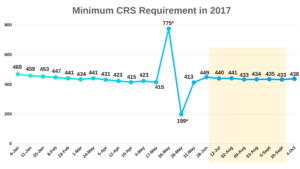Express Entry Report: Looking at the Third Quarter of 2017
So far, 2017 has proven to be a dynamic and active year for Canada’s Express Entry immigration selection system. At the end of this year’s third quarter, the number of candidates issued an Invitation to Apply (ITA) is the highest it has ever been since Canada first introduced the Express Entry selection system in January, 2015.
Despite the decrease of ITAs issued in the third quarter of 2017 in comparison to the record high number of ITAs issued in the second quarter, the number of ITAs issued was more than double the number for the same period last year. Additionally, the third quarter of 2017 saw a decrease in the minimum Comprehensive Ranking System (CRS) score required in order for a candidate to be issued an ITA.
The large number of ITAs issued thus far in 2017 follows a stated goal from Immigration, Refugees and Citizenship Canada (IRCC) to utilize the Express Entry system to welcome newcomers based on human capital factors over other factors, such as an offer of employment. Improvements to the system made last November and in June, 2017 have helped IRCC to realize this objective.
July, August and September by the numbers
In the third quarter of this year, a total of 18,135 ITAs were issued, 12,841 more than over the same time period in 2016. During the third quarters of 2015 and 2016, a total of 9,084 and 5,294 ITAs were issued, respectively.

The third quarter of 2017 saw 26 percent more ITAs issued than the sum of ITAs issued in the third quarters of 2015 and 2016. As indicated in the graph below, every quarter of 2017 has witnessed a record-breaking number of ITAs issued in comparison to previous years.

Overall, 69,420 ITAs have been issued up to and including the third quarter of 2017 to candidates in the Express Entry pool. This figure is more than three times larger than the 20,580 ITAs issued up to the same period in 2016, and all together higher than the total number of ITAs issued in any previous annual total.
Decrease of CRS cut-off threshold
Over the late summer months of 2017, IRCC invited candidates over a series of six Express Entry draws, two draws fewer than the previous quarter. In the third quarter, the lowest CRS points requirement of 433 occurred in two instances, the August 9 draw and again on September 20.
The graph below indicates the CRS cut-off thresholds over the course of 2017, with the third quarter highlighted.

*Note: Draws of May 26 invited provincial nominees with a minimum CRS score of 775, and candidates in the Federal Skilled Trades Class with a minimum score of 199.
Over the course of the third quarter, the CRS points requirement went from 449 coming into the quarter to 433, in the final draw of September. The first draw of the quarter saw the largest decrease between two draws, with a drop of nine points to 440, though the eight-point decrease between the draws that took place on August 2 and August 9 was another significant decrease in CRS cut-off requirements.
Provinces actively seeking candidates
Provincial nomination continues to be the single most valuable way for Express Entry candidates to increase their CRS score. In the third quarter of 2017, British Columbia (BC) and Saskatchewan introduced changes to their Express Entry-aligned enhanced Provincial Nominee Programs (PNPs). This is a clear indication that provinces continue to recognize the significance of Express Entry as a main driver of economic immigration to Canada.
In late July, the province of Saskatchewan introduced an expanded list of eligible in-demand occupations for its popular International Skilled Worked- Express Entry category of the Saskatchewan Immigrant Nominee Program (SINP). With an expanded list, eligible candidates in the federal pool with work experience in one of 43 in-demand occupations are given the opportunity to submit an application for provincial nomination under the SINP, when the sub-category reopens on a first-come, first served basis, as has occurred four times so far in 2017. Many of these occupations are geared towards candidates in the technology sector, though candidates across many other sectors may also be eligible.
Another benefit for tech and IT candidates was the announcement by the government of BC of a new BC Tech Pilot, where tech-focused draws target individuals from a list of specific occupations to meet the demand for tech talent in BC. The British Columbia Provincial Nominee Program (BC PNP) operates its own points-based immigration system, part of which is aligned with the federal Express Entry system. Over the summer months, scores for Express Entry-aligned categories in BC have decreased, allowing more candidates in the federal Express Entry pool a greater chance of receiving an enhanced provincial nomination, which, like the SINP sub-category mentioned above, comes with 600 additional CRS points and an ITA at a subsequent draw.
Meanwhile, other provinces across Canada have continued to leverage Express Entry into their respective PNPs, providing opportunities for candidates in the pool to increase their scores.
Options available to candidates with low core CRS
In addition to PNP options, candidates in the pool may improve their CRS scores by other means.
In the Express Entry system, a core CRS indicates a candidate’s score without any additional points awarded for a provincial nomination, an offer of employment, or post-secondary education obtained in Canada. More than half (55 percent) of candidates who received an ITA in 2016 had core CRS scores of less than 450, the lowest score drawn in 2016. Approximately 6,000 of these candidates had core CRS scores lower than 300. Core CRS indicated a candidate’s score without the additional points for a provincial nomination, a job offer, or post-secondary education obtained in Canada.
Since last year, new additional points were introduced for candidates with a sibling in Canada, resulting in some candidates seeing a boost of 15 points to their existing score. In addition, candidates with French ability may now receive 15 or 30 additional points.
Further, and as was also the case before those changes were introduced, candidates may improve their score by obtaining a qualifying job offer, completing an educational credential, proving a better language ability, gaining additional work experience, or, if applicable, having their spouse or common-law partner prove their level of education attainment, language ability, and/or work experience.
Commenting about some of these changes, Immigration Minister Ahmed Hussen stated at a conference in June, “As we do these innovative programs, we still have the strong commitment that we have to reuniting families. We know that when families are able to reunite and stay together, it improves their integration into Canadian society, their economic outcomes, and their ability to contribute to our communities, and our great country.”
The introduction of those additional points demonstrates the evolving nature of the CRS system through immigration policy that is aimed at increasing the opportunities for candidates in the pool.
What to expect for the remainder of 2017 and beyond
In efforts to enhance immigration efforts, provincial, federal and territorial members of government met this September to discuss ways to increase immigration levels and establish better immigration planning models for upcoming years. This year’s annual immigration levels plan sets a target of 300,000 new permanent residents in Canada by the end of 2017. However, Minister Hussen confirmed in a mid-year conference that this figure serves as a baseline for immigration targets under the current government.
As IRCC continues to introduce new initiatives, such as the Global Talent Stream, the Atlantic Immigration Pilot Project, changes to the Express Entry system, and new citizenship regulations, skilled workers, as well as recently graduated international students in Canada continue to be the a prime focus for economic immigration to Canada.
Up to and including the third quarter of this year, larger draws, higher target intakes, and a cleared backlog of pre-Express Entry applications have resulted in lower CRS cut-off thresholds. These factors, along with IRCC actively seeking skilled workers in the pool, gives candidates and other stakeholders reason to believe that more ITAs may be issued in the last quarter of 2017 going into the new year.
“Quite frankly we need to fill the skills shortages that exist in Canada,” Minister Hussen said in Toronto late June. “And by allowing highly-skilled immigrants to come to Canada and share with us their skills and their talents, we allow them to also help us create more jobs for Canadians, and more prosperity for all of us.”
Attorney David Cohen says, “Express Entry continues to provide individuals and families around the world the opportunity to make Canada their new permanent home. To begin, however, it is important to evaluate all the options available. If eligible, it is then crucial to enter the Express Entry pool and showcase ones credentials to provinces, as well as the federal government, which ultimately decides who may be selected.”
The CRS Calculator
Readers can use the new and improved CRS Calculator to find out what their score would be under the updated system.
To find out if you are eligible to immigrate to Canada permanently, fill out a free online assessment form.
© 2017 CICNews All Rights Reserved
- Do you need Canadian immigration assistance? Contact the Contact Cohen Immigration Law firm by completing our form
- Send us your feedback or your non-legal assistance questions by emailing us at media@canadavisa.com







